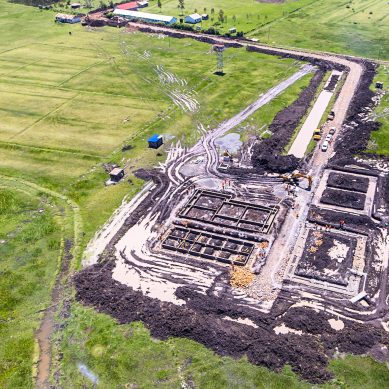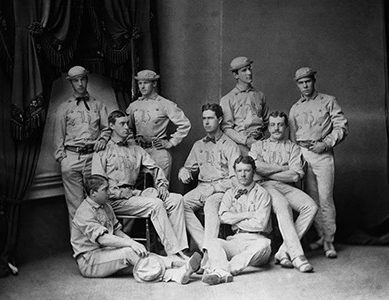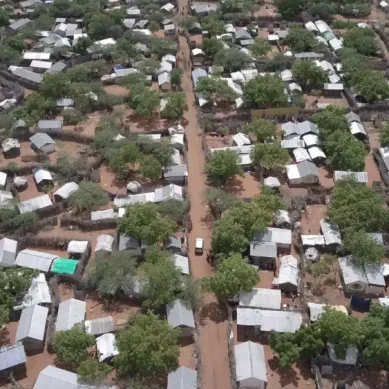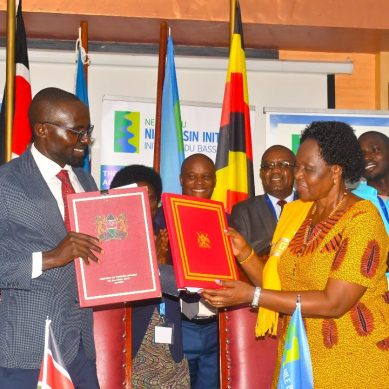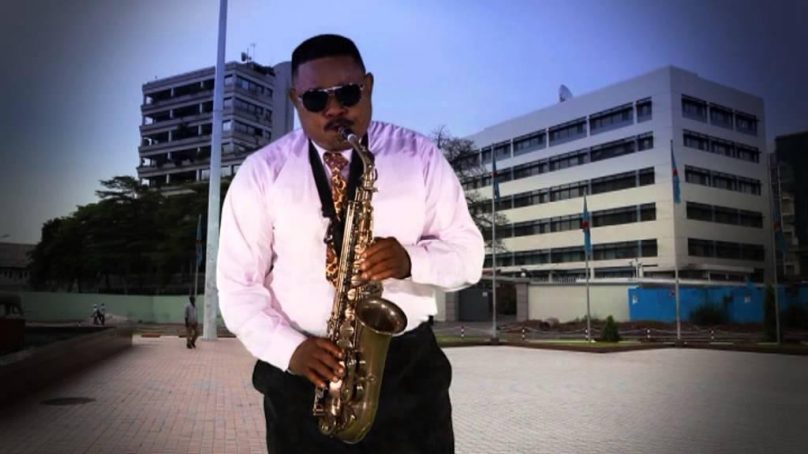
Rhumba Big Bang: Franco and Verckys split that reshaped African industry music forever
A rebellion in Orchestra Oscar Kashama (OK) in 1968 gave Africa rich a cultural diversity that lives on to this day.
It happened when OK – later renamed Orchestra Kinshasa – band leader Luambo Luanzo Makiadi (Francois) was away on a business trip in Europe and forever changed the course, tenor and tone of music in the Republic of Congo and Africa.
The rebellion was masterminded by Franco’s bosom friend, Georges Kiamuangana Mateta, who persuaded vocalist Youlou Mabiala and four others to record four tracks in the boss’s absence. The move was the root of a bitter disagreement between Franco and Kiamuangana.
The rift that followed was to remain to the day Franco died. The two never saw eye to eye and their genres too were worlds apart. But in the entertainment industry music lovers rejoiced: the more the merrier!
The split added variety to a menu that was already predictable with the sonorous rhumba beats. The rivalry between Franco and Kiamuangana injected into music a dynamism that elevated Lingala music to unrivalled levels in East, West, Central and Southern Africa.
Today, the variants of rhumba that followed are played throughout Africa with slight adaption to local tastes and dance style. The nexus, though remains Congo, where the Big Bang that separated Franco and Kiamuangana happened, and dispersed to the rest of Africa – especially east and southern Africa.
Franco and Verckys came from different social and economic backgrounds, which inevitably defined their career paths, influence and degree of successes. It played a part in their acrimonious split. What is never in doubt is the legions of highly talented artistes they mentored and gave to the world. The prodigies still dominate the music scene beyond Africa.
A critic, Jerome Ogola, compares Franco to all great footballers: Brazil’s Pele, Argentina’s Messi, Kenya’s Joe Kadenge or Mazambique’s Eusebio. They all came from poor backgrounds.
“Unlike Franco who was a hoof-eater from Sona Bata, Verckys came from a rich family. His father was a wealthy businessman in Leopoldville (Kinshasa). Good footballers and athletes rarely come from Elgon View (rich neighbourhoods); they always come from the slums. Poverty is known to nurture talent. Franco is a Kimbangiste like Topoké Fatale. This was a sect founded by Simon Kimbangu, a freedom fighter of DRC,” writes Ogola to illustrate the difference between the two music icons.
Topoke was a poor neighbourhood out of which emerged Simon Kimbangu. Like Elijah Masinde and Dini ya Msambwa in Kenya, Kmbangu was a Congolese religious leader and self-proclaimed special envoy of Jesus Christ and the Holy Spirit. He was venerated by the followers of Kimbanguism who regarded him as the Holy Spirit whom Jesus Christ promised he would send to the world to reclaim sinners. Those were Franco’s roots.
At 17 years of age, Kiamuangana adored American saxophonist King Curtis and even took on his name – Curtis. However, he could not pronounce it properly, hence Verckys. It became his brand name and label. As his music and business grew he modified his name to Kiamanguana Mateta wa Nzela Mbongo (with wa Nzela Mbongo alluding to his success in business. The modified part refers, literally, to: pursuing the road to business).
Verckys learnt music in church. By contrast, Franco owned a homemade guitar he used entertain his mother’s customers with on a roadside in the slums where she hawked groundnuts, samosas and mandazi (puff) to feed her children. Franco’s father died when he was toddler.
While Kiamuangana interwove his music and business acumen with ease, to Franco – with little education – entertainment preceded business.
Franco through sheer grit and hard work managed later in his career to coalesce the two into a music empire that still stands nearly three decades after his death on October 19, 1989.
A lot has been said about Franco’s achievements. Rarely does the music industry feature Verckys, despite his influence on the rhumba music, particularly the soukous genre.
Kiamuangana owned one of the biggest bands ever in the history of Congolese music, Orchestra Vévé. He is multi-talented. Apart from his mastery of the saxophone, comparable to other African great jazz saxophonists such as Manu Dibango and Hugh Masekela, he is also a songwriter, singer, guitarist, keyboardist and a gifted studio engineer.
He launched music career in 1962 with Los Cantina before he joined Jamel Jazz. Within a short time, he had joined Paul Ebengo, who was popularly known as Dewayon with is Congo-Rock band. It didn’t take long before he moved to OK Jazz in 1963, bringing with him some musicians from Congo-Rock: Gerard Kazembe; Christophe Djali on trumpet, singer Henriette Boranzima and Dele Pedro.
He met Franco when the latter together with Vicky Longomba, Jean Serge Essous, De La Lune, Augustin Moniania Roitelet, La Monta Li Berlin, Saturnin Pandi, Nicolas Bosuma Bakili Dessoin and vocalist Philippe Lando Rossignol, used to perform at Oscar Kashama (OK) Bar in Kinshasa. Formed in June 1956, the name OK Jazz originated from the bar in which they played.
In 1957, the lead vocalist Philippe Lando Rossignol quit OK Jazz and was replaced by Edo Nganga, from Congo-Brazzaville. Later in the same year, Zimbabwean saxophonist Isaac Musekiwa joined the band. The band’s leadership was shared between Vicky Longomba, Essous and Franco.
The camaraderie between Franco and the other two did not last long. Vicky Longomba and Jean Essous left OK Jazz to join African Jazz in early 1960, which left Franco as sole band leader.
This gave him room to rope in new talents: Kwamy Munsi and Mulamba Joseph Mujos. The following year Simaro Masiya Lutumba came in, at the same time saxophonist Essous was replaced by Verckys.
OK changed its name to TPOK, with OK acronym becoming Orchestra Kinshasa, then Tout Puissant Orchestra Kinshasa, with Kiamuangana as one of the most visible members of the band because of mastery of the saxophone, attire and stage chants.
At 25 years of age, Verckys was already thinking business and the success he had with TPOK provided enough impetus to convince him to leave. The rhumba beat then was a slow sonorous beat akin to the R&B.
Kiamuangana more more energetic African beats that characterised the rapid and explosive soukous derivative of rhumba. Added to the benga beat that was emerging in Kenya, Verckys, in his words while on tour to Kenya in early 1980s, was taken in by the “talking guitar” of benga.
Verckys left TPOK after the departure of Kwamy Munsi and Mulamba Joseph Mujos, who led nine other musicians in a mass defection. Rondot Kassongo wa Kassongo was brought in to replace Verckys. Also, in came Mose Fan Moose as Franco sought a fusion of rhumba and the new style of guitar-playing called sebene that was more danceable.
On April 5, 1969 he quit TPOK to form Orchestra Vévé in which Bovic Bondo featured as a vocalist with Ramazani Nkalu-Luaka. The two featured the tracks Ndona and Gina. Ndona was Verckys composition in memory of his mother who died while he was away on a business safari.
Orchestras Veve soon welcomed Marcel Loko Massengo or Djeskain, Sinatra Bonga Tsekabu or Saak Saakul and Mario Matadidi. The three would later form the Trio Madjesi, then formed Orchestra Sosoliso, but under the Verckys stable.
When Verckys started recording, his instrumentation was a trimmed sound than OK Jazz, which allowed room for wild saxophone solos in the sebene style that became his trademark and selling point.
The original Orchestra Veve had Danila on solo guitar, Jim on bass and veteran Maproco and Verckys on saxophones. The band copied Dr Nico Kassanda’s beat and dance style, Kassanda’s Kiri Kiri, which later transited the gentler and more seductive Cavacha. All the none satellite bands that record under his record label had their own variations of Cavacha with priority given to dancehall performance.
Cavacha were for their prominent lead guitar that followed the ebb and flow of the vocals, although in most songs it played the role of a soloist, cuing in the vocalists. The rhythm became prominent and robust mid-song that signified the “climax” or “peak” of the song.
The inventiveness in the Cavacha style was the precursor of Soukous, Kwasa Kwasa, Choc Choc, then Madiaba and Pesa Posa, among others.
Veve kicked off with Mfumbwa and Bankoko Baboyi composed by himself. The tracks were followed by Saakul’s Fifi, then Ah Mokili and Akipaka Ngai Te.
Jerome Ogola, a Lingala music fa writes in Why you must know Verckys Mateta Kiamuangana:
“Apart from being a talented sax player, having played with Franco’s TPOK Jazz for eight years, he is the first indigenous African to own a record label. He opened a then state of the art recording studio, Editions Vévé, in 1971.
Vévé went on to nurture and produce the biggest names in the continent’s music in the 70s. Orchestra Lipua LiPuma and Orchestra Veve were his signature bands. With an unerring ear for quality, Verckys also recorded and produced Les Grands Maquisards, Orchestra Kiam, Bella Bella, Shama Shame, Grand Piza, Les Kamale and Empire Bakuba, the most interesting bands to come up in his generation.
He also recorded Thu Zaina, whose guitarist Roxy played on some Vévé recordings. He also sponsored Sosoliso, Victoria Eleison and Zaiko Langa Langa, perhaps the oldest music ensemble in the Democratic Republic of Congo today.
Ever business-minded, he allowed his popular singers to break away in 1972 to form Trio Ma-dje-si (Matadidi-Djeskain-Sinatra) with their own band Orchestra Sosoliso, relocated to Congo Brazzaville. It remained one of his top satellite bands.
How did he achieve all this? It all started with help from Roger Izeidi. Vercky, then only 25, built the first African-owned studio on Avenue Eyala, in Kasavubu estate in the capital Kinshasa. His early 1970s recordings were collected on the Sonodisc label and his mid-career output as a producer appeared in a great nine-volume series Les Grands Succès des Editions Vévé on the Sonafric label.
The collections featured many hits produced in his studio by Vévé and other bands such as Lipua Lipua, Les Kamale, Orchestra Kiam, and Zaiko Langa Langa. Then in 1972 he brought on board two youngsters from Orchestra Bella Bella – Pepe Kalle Yampanya and Nyboma Mwandido to sing Sola, Mbuta and Kamale.
Such was Verckys success that during a visit to Kinshasa, James Brown, referred to him as Mister Dynamite! The James Brown-influenced Ndona featured Verckys on saxophones and chants, Roxy Tshimpaka on solo guitar, Pierre Monongi Mopia on rhythm, Jim on bass.
They were Ramazani Nkalu-Luaka, Tusevo Nejos, Feu Pepito, Pascal Mangwana (Sam Mangwana’s younger brother) and Jojo Ikomo, who later formed Bana Ngenge and shifted base to Nairobi. Jojo Ikomo later joined TPOK.
Verckys founded Editions Vévé in 1974. In 1976 he changed the name of his label to ZADIS (for Zaire Disc). That year he issued Baluti and Muana Mburu that were composed by Francis Bitsoumani (Celi Bitsou).
The lineup was made up of Tino Muinkwa, Djo Roy, Nejos Tusevo, Pepitho Fukiau on vocals, while Lambion was on solo guitar, Aladji Baba on rhythm, Ndolo and Celi Bitsou on bass, Bayard on drums, Ponta Vickys on congas, Dibuidi and Sax Matalanza on saxes and Makamba on trombone. After the success of Muana Mburu, Celi Bitsou went solo.
Verckys retired from performing to concentrate on his nightclub, his shop ZADIS on Place Victoire, his label, and promotion.
His Vévé Centre became the hotspot for Grand Zaiko WaWa, Langa Lange Stars, Victoria Eleison, Johnny Bokelo’s Mbonda Africa, Afro International, Wenge Musica and other groups.
Then in 1978 he recruited young sensation Koffi Olomide, who a decade later began to dominate the entertainment world to this day. The lure to record forced Verckys out retirement in 1980 to release new albums on the Vévé International label in Paris. His band was renamed Vévé International.
Verckys was elected president of the Congolese Musicians Union in 1988. Poor health has slowed him down but he still keeps an eye on his business at home and Europe.
- A Tell report/JK
